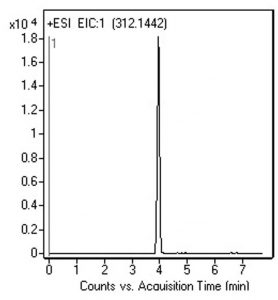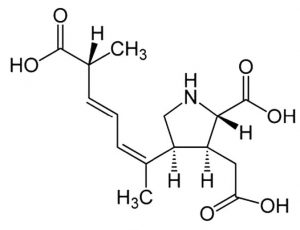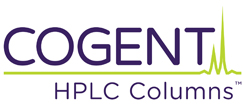Determination without derivatization
To date, several analytical methods have been developed for the quantitative determination of Domoic Acid (DA). However, many of the methods require tedious and labor intensive derivatization of this compound in order to detect it.
A new method based on HPLC and MS detection which does not require derivatization has been developed. A simple linear gradient and typical MS compatible mobile phases were used to retain DA, a potent Neurotoxin.
The method can be used by regulatory agencies responsible for monitoring the occurrence of toxins for analysis of Domoic Acid in seafood samples and other laboratories.


Peak:
Domoic Acid 312.1442 m/z (M + H)+
Method Conditions
Column: Cogent Diamond Hydride™, 4μm, 100Å
Catalog No.: 70000-05P-2
Dimensions: 2.1 x 50mm
Mobile Phase:
—A: 50% Methanol / 50% DI Water / 0.1% Formic Acid
—B: 97% Acetonitrile / 3% DI Water / 0.1% Formic Acid
Gradient:
| Time (minutes) | %B |
| 0 | 95 |
| 10 | 30 |
| 11 | 30 |
| 12 | 95 |
Post Time: 5 minutes
Flow rate: 0.4 mL / minute
Detection: ESI – POS – Agilent 6210 MSD TOF Mass Spectrometer
Injection vol.: 1μL
Sample Preparation:
—Stock Solution: 1mg / mL in Methanol diluent.
—Working Solution: Stock aliquot was diluted using 50% Solvent A and 50% Solvent B mixture for the final concentration 0.5mg / L. Before injection, solution was filtered using a 0.45µm Nylon Syringe Filter (MicroSolv Tech Corp.).
Note: Domoic Acid, a compound known for over 50 years, was found to have neurological effects when ingested by humans. It is the chemical responsible for amnesiac shellfish poisoning (ASP). Upon ingestion by humans, it can cause diarrhea, dizziness, seizures, permanent loss of short-term memory, and even death. In Canada, the European Union, and the USA, the legal limit is 20 µg DA / g in wet tissues of shellfish.
Attachment
Domoic Acid by LCMS pdf Download File


